Long before the red carpet became an industry, the Academy Awards were known as the ‘Armani Awards’.
By Marta Represa
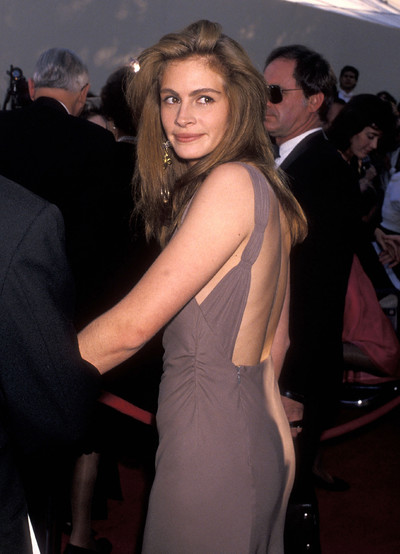
Long before the red carpet became an industry, the Academy Awards were known as the ‘Armani Awards’.
On 28 March 1990, two days after the 62nd Academy Awards had taken place, Women’s Wear Daily ran an article titled ‘The Armani Awards’. ‘Most of the big-time stars,’ it boldly declared, ‘dumped the glitz and opted for Giorgio’s greatest hits.’ Those stars included Kim Basinger, Robert De Niro, Steven Spielberg, Julia Roberts, Jodie Foster, Denzel Washington, Steve Martin, Tom Cruise, Jeff Goldblum, Dennis Hopper, Daryl Hannah and Billy Crystal, to name only a few. ‘The star of the night,’ the article concluded, ‘was Michelle Pfeiffer, who kicked off Armani-mania last year with an androgynous suit, but this year went for a sleek navy column.’ Yet in many respects, the true star of the night was Mr. Armani himself.
A decade after the parade of nonchalantly chic greige suits worn by Richard Gere in 1980s hit neo-noir thriller American Gigolo had first put the Milanese brand on the Hollywood map, Giorgio Armani was now crowned king of red-carpet style by Tinseltown en masse. It was the culmination of ten years of relationship building by a small team connected to both the movie and fashion industries, which had successfully taken stars out of worst-dressed lists straight into the best-dressed while providing flawlessly constructed tuxedoes for men and gowns – and tailoring – for women. A decade of Armani establishing a new sartorial paradigm, in which red-carpet ‘costumes’ gave way to a more natural kind of European elegance suited to the wearer’s personality. All conducted from Armani’s pioneering Rodeo Drive-based VIP dressing office.
Those ‘Armani Awards’ in 1990 also opened a new chapter for a brand whose influence in Hollywood would grow exponentially over the following 30 years – Armani has since been worn to the Oscars more than 500 times. While other houses were barely starting to wake up to the full potential of the red carpet, the label founded by the Piacenza-born designer was already dressing the pick of Hollywood for awards and events all over the world. Fast-forward to today’s rampant red-carpet industry – in which every major luxury brand vies for the attention of cinema’s biggest stars – and Armani remains both ubiquitous and synonymous with an unwavering elegance and glamour.
For System, Mr. Armani, along with key longstanding members of his VIP dressing team, as well as leading celebrity stylist Elizabeth Saltzman (whose own career in fashion started as an 18 year old at Armani) agreed to trace the origins and evolution of Armani’s singular presence at the Oscars. From the ‘New Hollywood’ revolution and friendships with the likes of Martin Scorsese and Francis Ford Coppola to industry competition and the Pygmalion-esque appeal of the fashion designer, they all unpack a pioneering Hollywood story.

The beginning of Armani’s rapport with the Oscars and red-carpet dressing dates back to the late 1970s, at a time when Hollywood’s historical studio system had given way to a new generation of younger, free-spirited filmmakers often labelled as ‘New Hollywood’. Had the film industry’s relationship to fashion and clothes also shifted?
Mr. Armani, Chairman and CEO of the Armani Group: The moment in history that saw the emergence of ‘New Hollywood’ corresponded to a general shift in the Western way of life. I was aware that society was undergoing a profound metamorphosis, and that impacted my vision. Of course, it wasn’t a developed idea per se at that time, but rather a desire to capture the spirit of the time and express it through clothing. That would go on to include Hollywood and film stars, too. I was interested in seeing actors as people, instead of distant, unapproachable deities.
Describe red-carpet style back then.
Mr. Armani: Theatrical and flashy. It was as though actors continued to play a role, even in their real lives.
Pantaleo Dell’Orco, Head of the Men’s Style Office: Menswear on the red carpet was very much in line with men’s style at the time: generally quite rigid and subject to lots of rules. It felt quite ready to be superseded.
Elizabeth Saltzman, stylist and Armani team member 1984-1992: At the time, the Oscars was not about fashion. It was an interesting night, but no different to watching the Miss America pageant. Nolan Miller, Arnold Scaasi or Bob Mackie were the designers synonymous with Hollywood. It was all evening dresses designed by designers who weren’t really selling in regular stores; or designed by the same people who did costumes for Carnival in Rio or who did Broadway; or the costume designers who worked on Hollywood movies. Givenchywas an exception, because he had a muse in Audrey Hepburn. And so Armani signalled a change, a shift in the Awards’ rapport with fashion, certainly European houses.
Mr. Armani: I thought a more natural and personal style was needed off-screen, to be more closely aligned with actors’ on-screen work. ‘New Hollywood’ stories and characters revolved around ideas of realism and continuity between cinema, performance and life. It was a new way of storytelling and expression. How could that not seep into fashion and style?
And then American Gigolo happened.
Mr. Armani: Yes. To my great surprise, [director] Paul Schrader contacted me and came to Milan in late July 1979 with John Travolta, who was initially hired to play the main character, Julian Kaye, before Richard Gere took the role. I showed him sketches of the Spring/Summer collection and he told me it was exactly what he had in mind. This is a point I’d like to make clear: the clothes worn by Richard Gere were collection clothes, not clothes designed specifically for the film. Richard Gere represented a modern man, and the modern men who identified with him could dress just like him.
Pantaleo Dell’Orco: The way we approached it was to dress Richard Gere just like a customer who had come to the store to change his image and wear Armani. The modernity lay in the relationship that the clothes had with the body, which, rather than being hidden, was always present. Add to this the choice of colours – a range of neutrals and greiges instead of traditional blues and anthracite greys – and you got a look that was unheard of at the time.
Mr. Armani: That’s also when I first visited Hollywood, and my first time on a movie set. Seeing a film being made was a dream come true for a cinephile like me. I found it so exciting, witnessing that ability to transform a story into visual expression.
Roberta Armani, Global Head of Entertainment Industry Relations: Interestingly, American Gigolo was never intended as a marketing exercise, yet it turned out to be exactly that. It really brought Armani to the world through the big screen. From then on, the brand became closely associated with the movies. To date, we’ve designed the wardrobe of over 250 films.
But Armani red-carpet dressing had actually debuted two years earlier.
Roberta Armani: Exactly, and it all went back to that idea of rejecting old Hollywood’s theatrics in favour of a more natural style. In 1977, my uncle had admired Diane Keaton’s performance in Annie Hall, in which she famously wore ‘what she wanted to wear’. He was taken with her style in the film, so he suggested she dress the same way for the Oscars in 1978. She won the Best Actress award wearing a man’s jacket. No actress had ever dressed like that at the Oscars before.
Mr. Armani: It really wasn’t a strategic choice; it was absolutely spontaneous, almost accidental. However, after American Gigolo, I realized the powerful impact that cinema could have on the collective imagination, and the desire to identify with a character’s style. From there came a structured strategy with commercial goals.
Wanda McDaniel, Executive Vice President Entertainment Industry Communications Worldwide: Mr. Armani was smart. He had loved film ever since he was a kid, and he saw Hollywood as a key way to bring his work to the world’s attention, so he started developing strong relationships with the new generation of actors and directors. He subsequently became the go-to designer for red-carpet events for those who wanted to make a more contemporary statement.
Roberta Armani: Robert De Niro, Al Pacino, they all wanted to look a little more relaxed on the red carpet to reflect the times they were living in.
Mr. Armani: I also bonded quite naturally with Martin Scorsese. His Italian origins, plus the perfectionism we both have in common, probably helped us have a very fluid dialogue that has continued over the years.
Wanda McDaniel: You could sense it – there was a new mood in town. Also among the women, who were tired of overstatement and wanted something more refined.
‘I wanted to express the spirit of ‘New Hollywood’ through clothing, and seeing actors as people, instead of distant, unapproachable deities.’
The Armani VIP dressing office in Los Angeles opened in 1988. How did the idea for that come about?
Wanda McDaniel: When I first met Mr. Armani, in 1987, I was working as a fashion journalist for the Los Angeles Herald Examiner. Maria Shriver told me he was looking for someone to help him open his largest store in the US to date, on Rodeo Drive. She had been tipped off by [her aunt] Lee Radziwill, who was then working as special events coordinator. I immediately thought it was the perfect job for me. I was married to film producer Al Ruddy, who made The Godfather, so I moved in circles where I knew industry people, actors, studio executives, directors, and producers. And of course, Mr. Armani already had a relationship with people like Martin Scorsese and Francis Ford Coppola, as well as Brian de Palma who he had worked with on the wardrobe of The Untouchables. I sat on the boards of places like the Women’s Guild Cedars-Sinai and the [Cayton] Children’s Museum, I was mixing with just the sort of clientele Armani needed to attract so that the look would trickle down, or rather trickle out, into wider society. The introductions were initially made through social events. It was a very Italian approach.
Mr. Armani: Wanda was already working in film; her contacts and strategic personality immediately convinced me she was the right person to handle our relationship with stars in the city. To this day, I think I’ve been proven right.
Wanda McDaniel: As I remember it, the idea suggested itself organically; it was a concept hiding in plain sight. The relationship between Armani and Hollywood had been developing in a very natural and unforced way for a while, so we came up with the idea of creating a specific VIP dressing office in L.A., even though terms such as ‘VIP department’ had yet to be established in our arena of work. When it opened in 1988, Mr. Armani tasked me to become his ‘Hollywood ambassador’, thus pioneering the area in the entertainment world. My husband and I attended the famous Swifty Lazar Oscar-watching party in 1989. All of the glittering dinner guests commented on the garish attire on the red carpet. That’s where the idea was born – when Jodie Foster won Best Actress wearing a sky-blue gown with an overwhelming bow in the back. I turned to my husband and said, ‘Next year, I’m dressing her for the Oscars.’ When I called Jodie to congratulate her, she told me she bought that gown straight out of a store window in Milan! She didn’t like it, and admitted that fashion was not her forte. ‘From here on out,’ she said, ‘just tell me what I’m wearing.’ At the 1990 Academy Awards, Jodie indeed wore Armani, WWD dubbed the Oscars ‘The Armani Awards’, and the rest is fashion history.
Elizabeth Saltzman: It was the perfect storm: Armani was doing what nobody else was doing, organized in a way nobody else was, hiring all the right people, at just the right time. The clothes were structured yet fluid, which no one else was providing, and they were getting people out of uncomfortable and into comfortable. Men’s suits on women. But always with ease.
Barry Frediani, Vice President of Entertainment Industry Relations: In 1990, I was newly working at the Rodeo Drive location after two years in retail as the Armani specialist in the Armani shop-in-shop at the I. Magnin department store. The doors of the Armani boutique were constantly revolving with celebrity appointments, both in the VIP showrooms and on the shop floor. I recall being impressed with 1990 Oscars host Billy Crystal being fitted by Mr. Armani himself. Mr. Armani was in Hollywood to attend the Oscars, and it was a true learning experience to watch him work.
Elizabeth Saltzman: Other brands were, at most, taking a bungalow at Chateau Marmont for a fortnight during awards season while at Rodeo Drive, you had Wanda and Barry: people who were part of the film world, who had their ear to the ground, knew what was going on. It was smart.
‘Jodie Foster won Best Actress wearing a sky-blue gown with a huge bow. I turned to my husband and said, ‘Next year, I’m dressing her in Armani.’’
Was there a clear idea from the start about what a film star should look like dressed for the red carpet in Armani?
Pantaleo Dell’Orco: It was all about modernity. The stars who wore Armani represented the present day.
Mr. Armani: I have always had my own idea of elegance, whether day or night, which I have adapted to the red carpet by working closely with the personalities I dress, and talking to them. For me, the person I dress is always more important than the clothes they wear.
Roberta Armani: It was about creating a moment for a star. Like Julia Roberts dressed in a grey suit with a shirt and tie for the 1990 Golden Globes. Or Jodie Foster moving in a year from the worst-dressed list to the best-dressed list at the Oscars when my uncle took her under his wing and fitted her personally. She won an Academy Award in 1992 for The Silence of the Lambs wearing a white suit that my uncle designed, outshining all those wearing ribbons and trains. It was the same for Sharon Stone, who at the Academy Awards in 1996 looked majestic in a long black velvet Armani coat, or more recently, Cate Blanchett, who is so powerful with her aura of restraint and sophistication.
Mr. Armani: Not every star needs a Pygmalion, but having one can perhaps help to avoid any missteps. Honestly, though, I don’t see myself as a Pygmalion; I’m simply someone who can suggest a style in which the dress literally disappears and what you really remember is the person wearing it.
Wanda McDaniel: By the early nineties, Armani was dressing so many people that it really became a thing. Often stars approached us, rather than the other way around.
Elizabeth Saltzman: Interestingly, Halston had his girls, and Armani had his, but somehow Armani crossed over. Even though they got all these different people who you weren’t expecting, you always knew it was Armani.
Wanda McDaniel: We were, of course, aware that Armani had become a kind of benchmark, which was flattering, but nothing really changed for us. We stayed true to our determination to dress people who we admired and liked, and who genuinely liked the design and aesthetic of Armani.
What was the first hint that things had entered a new era, in terms of the scale and competition from brands trying to secure deals with Hollywood stars?
Wanda McDaniel: It started to feel a little different at the turn of the century; designers had understood the power of the red carpet, and had seen how successful Armani had been in this area.
Roberta Armani: I started formally working in entertainment-industry relations in 2000, after dreaming of being an actor myself for a couple of years, which meant I had experience with the movie industry. Things have definitely changed over the past 20 years; they were changing even before then. I can’t remember an obvious turning point, until the rise of digital and social media, which without question has had a huge impact on the red-carpet ‘industry’. Those images are now around the world instantly, on everyone’s phones.
Wanda McDaniel: The opportunity is greater, but the stakes are also higher if you get it wrong.
Roberta Armani: While witnessing these changes, we’ve stayed true to our own principles. We keep working with celebrities and VIPs who genuinely like what we do. Otherwise we wouldn’t be authentic. And neither would they.
Wanda McDaniel: People are wise to things that feel contrived or false, so the star and the brand really need to align.
Roberta Armani: It’s not about simply trying to promote the brand in any way possible. We look for genuine relationships with people who are close to the brand’s aesthetics and philosophy. Take Cate Blanchett, for instance: my uncle spotted her early on in her career as a very talented actor who also possesses incredible poise and a calm spirit.
What do Armani’s red-carpet operations look like today?
Wanda McDaniel: We’re not only Hollywood-centric, but we’re on high alert during Oscars season. It’s logistical, yet intensely personal. The people we dress are always old friends – or new ones – and we want to do the best we can for them. Armani has become a byword for red-carpet dressing not because we have a strategy, but because we are helpful and do our best to make people look great. So they come back.
Barry Frediani: We prepare for the Oscars months in advance, before nominations are announced. There are red carpets from the first week of January until the Oscars in March that require a lot of planning and ordering of custom tuxedoes. We meet with costume designers, publicists and agents for strategic placements of Armani.
‘I watch Mr. Armani walk into rooms and people practically bow, out of the respect he commands and deserves. They do the same for… the Pope!’
When it comes to red-carpet dressing, what does Armani represent today?
Elizabeth Saltzman: From the get-go, the secret to Armani’s red-carpet success was that the brand offered pure elegance. It wasn’t ‘fashion’; it was chic. There was no mistake on the red carpet, and who wouldn’t want to feel secure in that way? To this day, I agree with that. Looking at clothes in general nowadays, I often wonder where the hell are the clothes? Show us some elegance! And that’s exactly what Armani delivers.
From the actors’ perspective, what does Armani represent today?
Elizabeth Saltzman: I actually discussed this with a client today. I want to say this: when I put people in Armani it’s not for a pay check. I just believe that there are moments when you need to celebrate iconic people. I asked Armani to make something for Jodie Comer, because I thought, ‘You know what, there’s a sense of wanting to pay respect to the maestro.’ It’s important and I think it’s a rite of passage for youth, because you don’t know how long the legends are going to be around for. He’s done it all, and is still doing it, and has never handed his business over. And with Armani today, it’s not about ‘cool’; it’s about excellence. It’s a label that transcends cool. That’s the key.
Pantaleo Dell’Orco: Of course, it’s not the nineties any more, but I think our timeless style, which is both highly natural and elegant, is still a winner in a world that has become so noisy.
Mr. Armani: The relationship between fashion and entertainment is now closer than ever, and brands promote primarily via the personalities wearing them in the public arena. I myself do not shy away from this strategy, but I do not believe it should be the only way to communicate a brand’s values. That way, we risk flattening our work by equating it to that of costume designers for celebrities. The truth is that clothes are also objects and part of our everyday life.
Elizabeth Saltzman: Ultimately, that self-assurance and quality commands respect. To this day, I watch Mr. Armani walk into rooms and people practically bow. It’s an expression of the respect he commands and rightly deserves. They do the same for… the Pope!
Armani at the Oscars
1978-2023
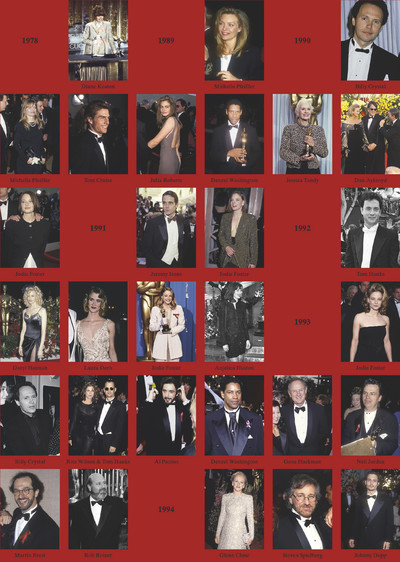
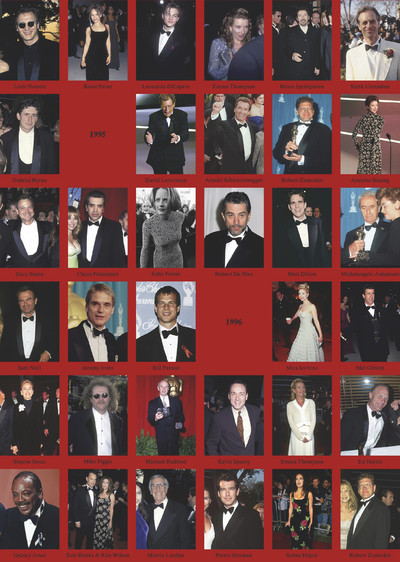
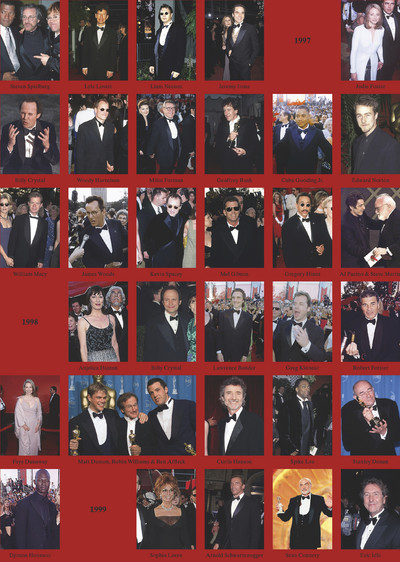
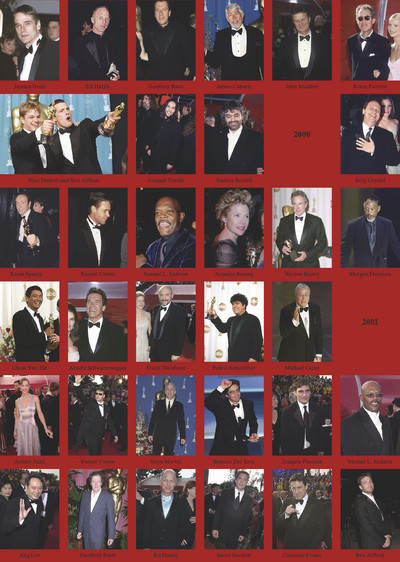
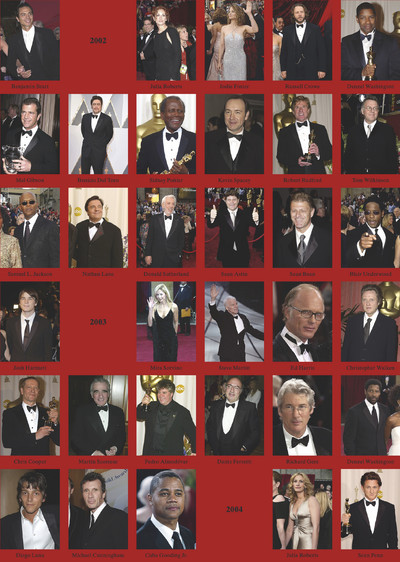
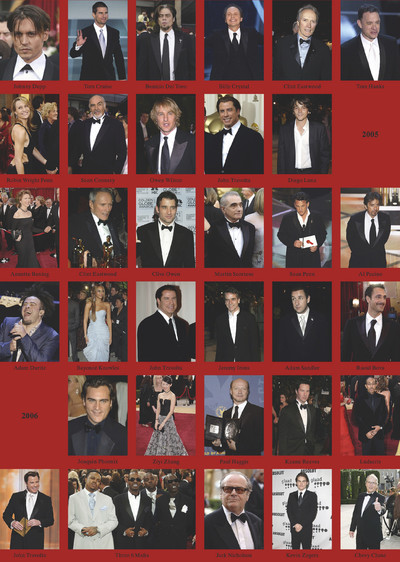
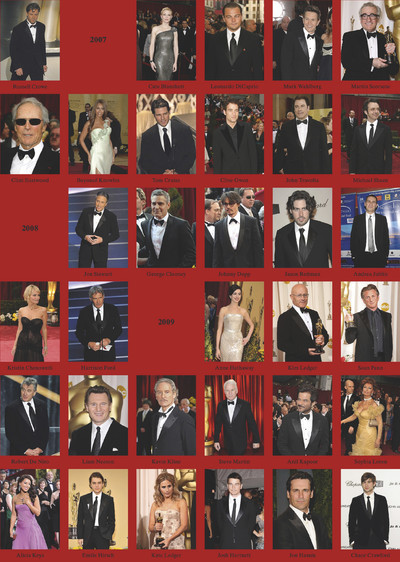
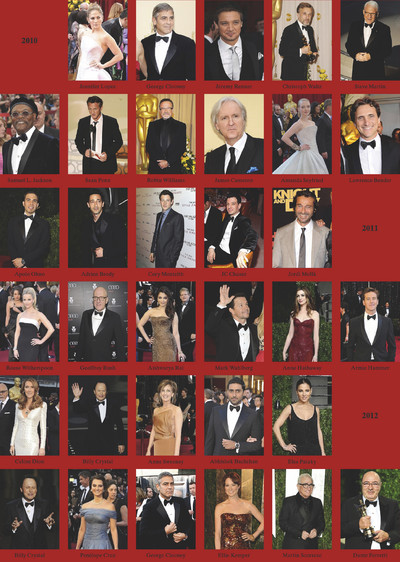
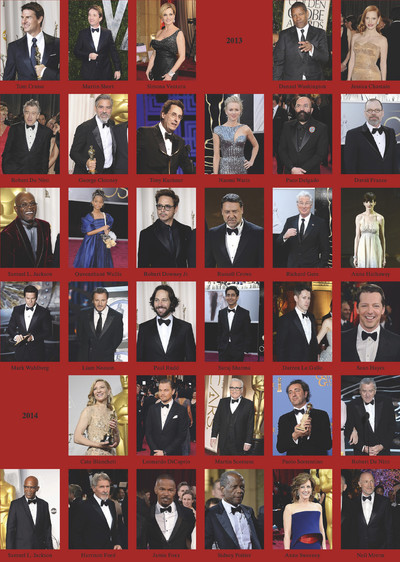
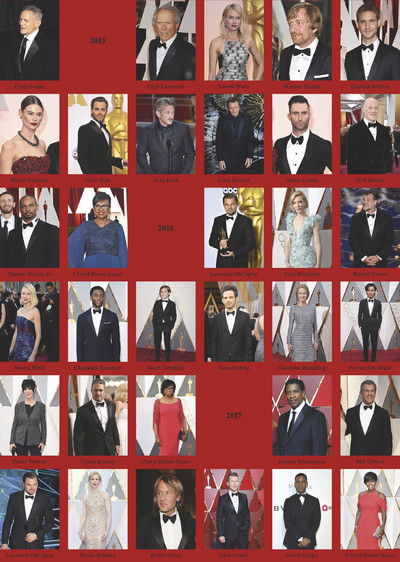
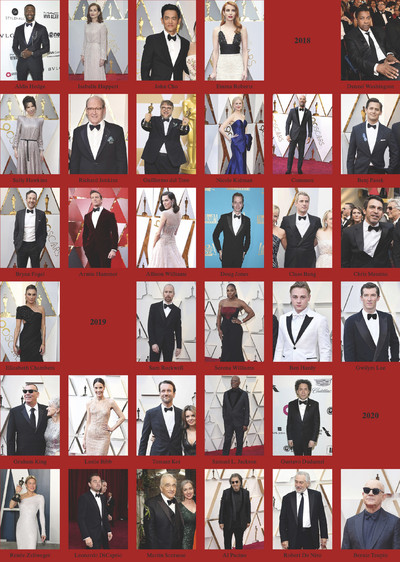
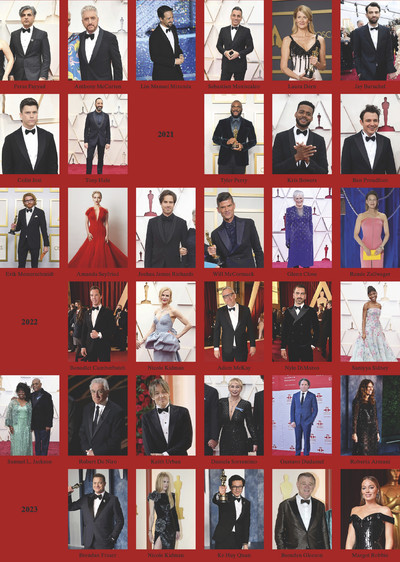
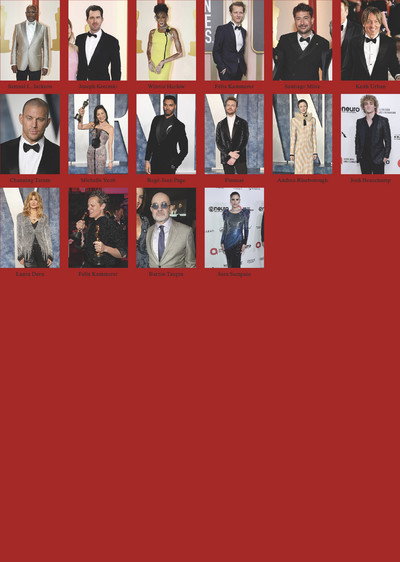
© Getty Images